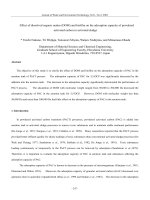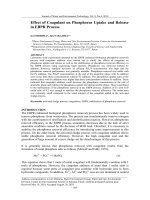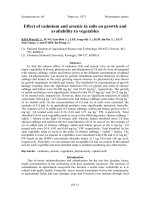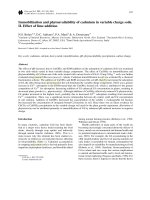Lipid in food and effect of lipid in food processing
Bạn đang xem bản rút gọn của tài liệu. Xem và tải ngay bản đầy đủ của tài liệu tại đây (75.4 KB, 12 trang )
Lipid in food and effect in food processing
Together with proteins, carbohydrates and water, lipids represent a major component of food
and important structural and functional constituents of cells in biological systems. Lipids are a
diverse group of compounds and serve many different functions. In foods, lipids contribute to
both the flavor and texture of foods and even with better taste when food contain more lipids.
Definition
Lipids represent the major bulk constituents in food and other biological materials. Lipids
comprise several classes of chemical compounds that have common solubility properties, i.e.,
soluble in low-polarity organic solvents such as chloroform, diethyl ether and light petroleum,
but sparingly soluble in water. Lipids are also composed of carbon, hydrogen and oxygen but
different to carbohydrate, they do not contain multiple hydroxyl groups which cause hydrogen
bonding, therefore, they are insoluble in water.
The term ‘fats’ may be applied to all lipid-soluble extracts from biological materials, or a
distinction may be made between oils, which are liquid, and fats which are solid. Chemically,
fats include many compounds which are fatty acids or esters of fatty acids. However, other
components are classified as lipids on the basis of their solubility properties, even though they
are not esters of fatty acid.
Lipids can be classified into three groups: simple lipids, compound lipids, and derived lipids.
Simple lipids are esters of fatty acids which produce two classes of compounds on hydrolysis.
Compound lipids are esters of fatty acids which produce three or more classes of compounds on
hydrolysis. Derived lipids cannot be hydrolyzed to fatty acids.
Classification and characteristic
There is only one characteristic that is common to all lipids, and that is their inability to
dissolve in water. They will, however, dissolve in a variety of organic solvents, such as benzene,
acetone, alcohol, carbon tetrachloride, and chloroform. This single commonality is generally
used to classify something as a lipid. Beyond that one charcteristic, lipids display a wide variety
of structures and features. They can be liquid or solid at room temperature, and they may have
other functional groups of various kinds attached.
Simple lipids
The main simple lipids are triglycerides (also known as triacylglycerols), steryl esters, and
wax esters. Hydrolysis of these lipids yields glycerol and fatty acids, sterols and fatty acids, and
fatty alcohols plus fatty acids, respectively. The most important of these simple lipids for food
scientists are the triglycerides.
Triglycerides are esters of the trihydric alcohol glycerol with three fatty acids. Many of the
properties of triglycerides are dependent on the component fatty acids. Thus, the melting point of
the triglyceride reflects the melting point of the component fatty acids, with three high-meltingpoint fatty acids yielding a high-melting triglyceride. Unsaturation in the fatty acids makes the
triglyceride susceptible to autoxidation, just as the fatty acid itself would be.
Reaction of triglycerides
Hydrogenation: involves not only the saturation of double bonds but also cis–trans
isomerization and migration of some double bonds to neighboring positions in the fatty chains.
Interesterification: a redistribution of the fatty acid moieties presented in a triglyceride oil
over its glycerol moieties.
Lipolysis: Triglycerides are hydrolyzed, albeit very slowly, by aqueous media, but much more
rapidly by basic catalysts and, more importantly, by endogenous lipolytic enzymes.
Autoxidation: Access of atmospheric oxygen to unsaturated fatty acids or glycerides leads to
deterioration through oxidation. Saturated and monounsaturated fatty chains oxidize very slowly
and do not as a rule caused problems. Oils such as fish oils are so liable to oxidative degradation
that they cannot be used as such in food formulation but must first be hydrogenated
Compound lipids:
There are many members of this group. Probably most important compound lipids for food
science are the phospholipids.
Phospholipids
Phospholipids are esters of glycerol, fatty acids, phosphoric acid, and other alcohols. The
most
common
phospholipids
are
phosphatidylcholine,
phosphatidylethanolamine,
phosphatidylinositol, and phosphatidylserine. These phospholipids share the common features of
fatty acids esterified to the 1 and 2 positions of the glycerol backbone with the phosphate group
esterified to the 3 positions. The phosphate group is the negatively-charged polar head, which is
hydrophilic whereas the fatty acid chains are the uncharged, nonpolar tails, which are
hydrophobic.
Phospholipids differ from triglycerides in being surface-active and they are used in food
products as emulsifiers because they migrate to the interface between oil and water, and reduce
the interfacial tension, thereby stabilizing an emulsion. Commercial phospholipid preparations
are called lecithin.
Lecithins
are
mixtures
of
glycerophospholipids
including
phosphatidylcholine,
phosphatidylethanolamine, phosphatidylinositol, phosphatidylserine, and phosphatidic acid.
Glycolipids
Glycolipids yield fatty acids, glycerol, and carbohydrates on hydrolysis. Monogalactosyldiglycerides are glycolipids which are commonly found in plant leaves and algae. They
contain a high proportion of polyunsaturated fatty acids and appear to play a role in
photosynthesis.. Sulfoquinovosyldiglyceride is one of the most polar plant lipids. Cerebrosides
and cerebroside sulfates are further examples of glycolipids.
Sphingolipids
Sphingolipids are derivatives of the amino alcohol sphingosine, which is found in animal
tissues, or phytosphingosine, which is found in planttissues. Lipids derived from other related
bases are included in this group. Sphingosine is one of more than 60 long-chain amino alcohols
found in animals, plants, and microorganisms. The bases commonly contain between 12 and 22
carbon atoms in the chain. A ceramide, which is an amide formed from a fatty acid and
sphingosine, is the characteristic parent structure of all sphingolipids.
Sphingomyelins are the most abundant sphingolipids in the tissues of higher animals. The 1hydroxyl group of ceramide is esterified with phosphoric acid esterified with choline or with
ethanolamine.
Cerebrosides are glycosphingolipids which contain a carbohydrate linked by a glycosidic
linkage at the 1-hydroxyl position of the long-chain base. Cerebrosides are the major
sphingolipids of plants.
Lipoproteins
Lipoproteins may also be classified as compound lipids. These are compounds of proteins,
fatty acids, and alcohols and may include other classes. Lipids and proteins are largely held
together by hydrophobic interactions. Transport lipoproteins and membrane lipoproteins are
important biomolecules in human physiology.
Derived Lipids
This group of lipids includes a range of compounds which vary widely in their structures. The
main derived lipids include: fatty acids, fat-soluble vitamins and provitamins, alcohols –
including sterols – terpenoids and ethers.
Fatty Acids
Although simple and compound lipids are esters of fatty acids, the free fatty acids only occur
in relatively small amounts in food and food raw materials. A fatty acid is a carboxylic acid with
a long aliphatic chain, which is either saturated or unsaturated. Most naturally occurring fatty
acids have an unbranched chain of an even number of carbon atoms, from 4 to 28. Fatty acids are
usually not found in organisms in their standalone form, but instead exist as three main classes of
esters: triglycerides, phospholipids, and cholesteryl esters. In any of these forms, fatty acids are
both important dietary sources of fuel for animals and they are important structural components
for cells.
Essential fatty acids, or EFAs, are fatty acids that humans and other animals must ingest
because the body requires them for good health but cannot synthesize them. Only two fatty acids
are known to be essential for humans: alpha-linolenic acid (an omega-3 fatty acid) and linoleic
acid (an omega-6 fatty acid). Some other fatty acids are sometimes classified as "conditionally
essential", meaning that they can become essential under some developmental or disease
conditions; examples include docosahexaenoic acid (an omega-3 fatty acid) and gamma-linolenic
acid (an omega-6 fatty acid).
Vitamin A
Vitamin A is a C20 primary alcohol occurring either as vitamin A1 or vitamin A2. It is
commonly used in the form of acetate or palmitate esters as a food additive.
Vitamin D
The term ‘vitamin D’ refers collectively to a group of compounds derived from sterols, which
are effective in preventing the development of rickets in children. Ergocalciferol (vitamin D2)
and cholecalciferol (vitamin D3) are the most common compounds with vitamin D activity.
Ergocalciferol is formed by the irradiation of ergosterol with ultraviolet light whereas
cholecalciferol is formed in an analogous manner from 7-dehydrocholesterol.
Vitamin E
Eight compounds belonging to the tocopherol and tocotrienol classes have vitamin E activity.
Vitamin K
Compounds exhibiting vitamin K activity possess a 2-methyl-1, 4-naphthoquinone ring with
differing chain-length polyprenyl substituents at the 3 position. The dietary requirement for
vitamin K by the adult human is extremely low, because the vitamin is synthesized in the
intestine by intestinal bacteria.
Carotenoids
Carotenoids contribute the yellow, orange, or red colors of many fruits and vegetables, such as
carrots, peaches, and tomatoes. They are commonly extracted with vegetable oils, including
crude palm oil, which is a rich source containing 500 p.p.m.
Sterols
Sterols are termed phytosterols, zoosterols, and mycosterols. Cholesterol is the main
zoosterol, but sterols in plants commonly occur as mixtures with b-sitosterol, campesterol, and
stigmasterol representing three of the major phytosterols. Molecules with a sterol-type structure
that lack an endocyclic double bond are termed sterols. Methyl sterols, also known as triterpenyl
alcohol, have an additional methyl group at carbon-4 in the A-ring of the molecule. Methyl
sterols and dimethylsterols commonly occur with sterols in plant membranes.
Terpenes
Terpenes are oligomers or polymers of isoprene, 2-methyl-1, 3-butadiene. Monoterpenoids
and sesquiterpenoids contain 10 and 15 carbon atoms respectively, and these components occur
in essential oils and are very important flavor compounds. Monoterpenoids include acyclic and
cyclic hydrocarbons, alcohols, ketones, or lactones such as myrcene, limonene, and menthol.
Sesquiterpenoids include bicyclic or tricyclic compounds such as zingiberene, which is the main
constituent of the oil of ginger, or caryophyllene, which occurs in the oil of cloves.
Diterpenoids include the bitter principles, which are commonly bitter and have physiological
effects. Triterpenoids and higher terpenoids have no flavor properties. Triterpene alcohols have
been found useful in the identification of oils in blends. Carotenoids are the major
tetraterpenoids, while chicle, which is used in chewing gum, is the main polyterpenoid used in
foods.
Ethers
Ether lipids occur in which one of the hydroxyl groups of a diglyceride or phosphatidyl ester
is linked to an alkyl group. The alkyldiacylglycerols are common constituents of some marine
oils while vinyl ethers or plasmalogens are found in blood.
Source of some lipids
Simple lipids
In foods, lipids are mainly found in the form of triglycerides which make up to 99% of lipids
of plant and animal origin. Triglycerides are the major components of edible oils and fats, often
representing more than 95% of refined oils.
The major vegetable oils and fats: castor oil, cocoa butter, coconut oil, corn oil, cottonseed
oil, groundnut oil, linseed oil, olive oil, palm and palm kernel oil, rapeseed oil, rice bran oil,
safflower oil, sesame oil, soybean oil, sunflower oil, etc.
Fats of animal origin: butter fat, lard and animal tallows, fish oils.
Compound lipids
Phospholipids are the major components of cell membranes. All oils and fats in their crude
state probably contain phospholipids as minor components. This is commercially available
mainly from soybean but also from rape, corn, and sunflower. Egg yolk is also a significant
source of phospholipids. However, the bulk of the phospholipids are removed by degumming
during the refining of edible oils.
Glycolipids are also found in the central nervous systems of some animals. Some can be
found in the chloroplasts of higher plants and algae, but generally at lower concentrations.
Sphingolipids are important membrane components in both plant and animal cells. They are
present in especially large amounts in brain and nerve tissue.
Derived Lipids
Fatty Acids
Edible oils usually contain only small amounts of free fatty acids when isolated from the
plant, animal, or microbiological source. Normal values of free fatty acids are below 5% in most
crude edible oils. The free fatty acids present are mixtures similar to those present in the
triglycerides. Most free fatty acids are removed from crude edible oils during refining because of
the undesirable effects on flavor, and the reduction of the smoke point caused by free fatty acids.
A refined oil usually contains less than 0.1% free fatty acids.
Vitamin
Vitamin A occurs in animal and marine products such as butter (1 mg per 100 g) and eggs (3.7
mg per 100 g). Vitamin A can also be formed in vivo from some carotenoids such as b-carotene.
Vitamin D occurs in fatty fish, dairy products and yolk milk. Vegetable oils in general contain
more vitamin E than animal fats, and vegetable oils rich in polyunsaturated fatty acids tend to be
good sources of vitamin E. The main dietary sources of vitamin K are green vegetables, which
commonly contain > 100 mg per 100 g.
Carotenoids
Carotenoids contribute the yellow, orange, or red colors of many fruits and vegetables, such as
carrots, peaches, and tomatoes. They are commonly extracted with vegetable oils, including
crude palm oil, which is a rich source containing 500 p.p.m.
Sterols
Sterols occur in the membranes of plants, animals, and microorganisms. Algae produce a wide
variety of sterols. Cheese, egg, organ meat are rich of cholesterol, the main sterolls.
Emulsification
Oil and water produce emulsion by stirring, however, the emulsion starts to break down
immediately after stirring is stopped. The purpose of emulsification is to stabilize emulsion state
by preventing break down which occurs due to creaming aggregation and coalescence. To solve
these issues, decreasing size of dispersed particles, reducing the density different of dispersion
and protecting the surface of oil droplets are effective.
There are two types of emulsion, O/W emulsion or oil droplets in water, which can be found
in ice cream and or milk, and W/O emulsion or water droplets in oil, found in butter and
margarine. Recently, developments of W/O/W type emulsion or water dispersed within oil
droplets of O/W type emulsion and O/W/O type, an opposite type emulsion have been
progressing. These multiple type emulsions not only make low calorie items such as cream
which contain less oil, but also stabilize the emulsion by dissolving the unstable substance
present in the deepest region of water droplets. Taste can also be enhanced by injecting
seasonings and flavors into the water droplets.
When fats and oils form into crystal, an emulsifier promotes and inhibits the growth which
prevents the formation of abnormal crystal. This function is utilized for margarine, shortening
and chocolate.
Emulsifiers are molecules that contain both a hydrophilic, water loving, and hydrophobic,
water hating, portion. Lecithin is an important emulsifier. Two of the bonded molecules are fatty
acids - these are hydrophobic. The third substance attached to glycerol is phosphoric acid that
has an amino alcohol attached called choline. Lecithin makes a good emulsifier because the
hydrophobic end dissolves in oil droplets and the hydrophilic end dissolves in water. In
emulsions the only place lecithin likes to be is at the edge of oil droplets with its hydrophobic
end in the oil and the hydrophilic end in the water. Oil droplets in water are protected in the same
way by lecithin so the emulsion stays stable for a long time.
Gelation
Gelation is the process of formation of gel from sol, in the so-called “sol–gel” process. Sol is
a colloidal liquid wherein nanoparticles are dispersed throughout. Sols are produced either by
growing nanoparticles within the liquid or by dispersing the nanoparticles (which are synthesized
by other means) in the liquid.
Gelation properties are important in determining the quality of various food products. In
addition to myofibrillar proteins, lipids play an important role in the formation of gel.
Phospholipids are amphoteric lipids that cannot be removed through rinsing. Paradoxically, the
addition of phospholipids increases or decreases gel strength. The textural characteristics and gel
strength were dependent on the phospholipids content, including total lipid levels and the types
of fatty acids. The gelation properties increased with increasing concentrations of sphingomyelin
and phosphatidylserine. Furthermore, increased levels of saturated fatty acids (SFAs) and
decreased levels of polyunsaturated fatty acids (PUFAs) increased gelation properties. Finally,
higher hydrophobic interactions and more disulfide bonds were shown to increase gel network
structure stability, resulting in improving gel strength.
Application of some lipids on processing of food
Fat and oils
Fats and oils are important ingredients in a variety of foods. They confer desirable
characteristics on several foods, contribute to tenderness to shortened cake, and by aerating
batter, fats aid in establishing texture in cakes; they also add flavor to foods and influence the
order in which components of flavor are released when foods are eaten, besides having a
lubricating effect and producing a sensation of moistness in the mouth. They are a medium for
transferring heat to foods.
For consumers, textural attributes of fats that arise from their molecular states are of primary
importance. Food texture is affected by fats by forming structures of crystalline networks and by
disruption of structure by interfering with non-fat networks. Fats present polymorphism, an
ability to exist in different crystal forms and the three major are α, β, and β' that differ in melting
points.
The melting profile of the fat crystals play key roles in determining properties such as texture,
stability, spreadability, and mouthfeel. The texture of products such as chocolate, shortenings,
and especially butter is determined by the concentration, morphology, and interactions of fat
crystals. Shortenings are fats that provide specific functional properties (softness, texture,
mouthfeel, structural integrity, air incorporation, heat transfer, and shelf life increase) to pies,
breads, pasta and others.
There has been an increase in the percentage of the population that is either overweight or
obese over the last years. The growing concern with the relationship between health, feeding, and
maintenance of healthy weight has boosted the market of foods with reduced energy value. Since
fat has higher caloric density than that of most nutrients in foods, reducing fat and cholesterol
content is currently one of primary trends in food product innovation. However, the successful
development of these products remains a challenge because fat plays multiple roles in
determining their desirable physicochemical and sensory attributes. Important attributes such as
smooth/creamy/rich texture, milky/creamy appearance, desirable flavor, and satiating effects are
influenced by the droplets of fat. Therefore, it is important to identify commercially viable
strategies that are capable of removal or reducing fat content of food products without altering
their sensory and nutritional characteristics.
There are some products in which fat plays important structural role, such as chocolate, ice
cream, and bakery products like biscuits, breads, and cakes.
Phospholipids
The molecular characteristics of the phospholipids dictate the application of lecithin. The
presence of both hydrophilic and lipophilic groups within a phospholipid molecule makes it
surface-active. This surface-active property plus the natural nature of lecithin contribute to
emulsification, anti-spattering, wetting, anti-staling, dough-conditioning and antioxidant
functions in foods. Emulsifiers are used in many food products owing to their ability to stabilize
oil and water dispersions.
Another use of lecithin that directly relates to its emulsification property is anti-spattering. In
margarine, which is a water-in-oil emulsion, spattering happens when water droplets coalesce
during heating. Lecithin surrounds water particles to slow down this coalescence and thus reduce
spattering. Lecithin also serves as a wetting agent in powdered or granular products. For
example, the addition of lecithin helps cocoa powder disperse easily in water. Lecithin is also
able to form complexes with starch and protein. One example is the ability of lyso-lecithin to
form a lipid–amylose complex that decreases wheat starch retrogradation.
Rancidification of fats and oils
Rancidification
Rancidification is the process of complete or incomplete oxidation or hydrolysis of fats and
oils when exposed to air, light, or moisture or by bacterial action, resulting in unpleasant taste
and odor. Specifically, it is the hydrolysis or autoxidation of fats into short-chain aldehydes and
ketones, which are objectionable in taste and odor.
In the presence of oxygen and/or ultraviolet (UV) radiation, most lipids will break down and
degrade, forming several other compounds. Oxygen is eight times more soluble in fats than it is
in water; it is this exposure that is the main cause of the autoxidation process, increasing the
saturation of the oil.
Hydrolytic rancidity, also called hydrolysis or enzymatic oxidation, occurs in the absence of
air, but with moisture present. This normally is accomplished through enzymatic peroxidation,
where enzymes found naturally in plant oils (i.e., lipoxygenase, cyclooxygenase) and animal fats
(i.e., lipase) can catalyze reactions between water and oil.
Another degradation process is microbial rancidity, in which micro-organisms such as
bacteria, molds and yeast use their enzymes to break down chemical structures in the oil,
producing unwanted odors and flavors. Water needs to be present for microbial growth to occur.
There are other contributing factors that can significantly speed up the rancidity process,
including: temperature, time, light, water, catalyst.
Appropriate storage
Rancidification can be decreased, but not completely eliminated, by storing fats and oils in a
place with little or no exposure to oxygen or free radicals, at a low temperature, and away from
light. Many oils are packed with nitrogen gas to help limit exposure to oxygen. Antioxidants are
often added to fats and oils to retard the development of rancidity due to oxidation and
hydrolysis. Antioxidants retard oxidation primarily by either hydrogen donation or electron
donation. Processors can use natural antioxidants such as carotenes, flavonoids, polyphenols,
ascorbic acid and tocopherols, or select from a range of synthetic antioxidants. However, these
natural antioxidants tend to be shorter-lived, so many bulk producers prefer using synthetic
antioxidants when a longer shelf-life is preferred. Vitamin E is among the best antioxidants for
oil because it is a powerful antioxidant that is soluble in oils and is considered a natural
compound.









